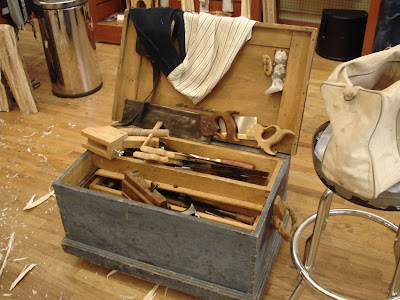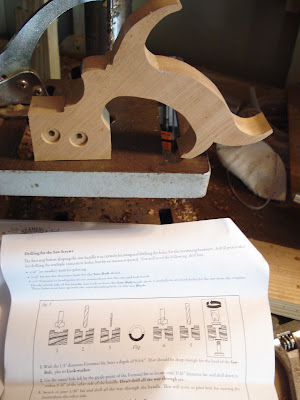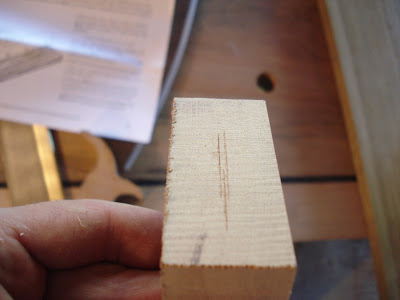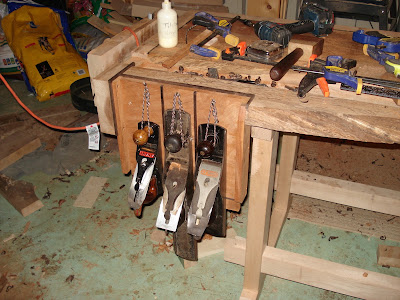In my very first post of substance--if any could be called that--I talked about making some drawers out of reclaimed firewood. I then put those drawers aside and went to town on the workbench. The other day I made a simple three-sided frame for them, screwed and glued some slides into place and mounted it underneath the bench.
So now I have a convenient place where I can keep my hand tools close by.
I've mentioned before how I've been a little disappointed with the face vise. There has always been a little too much play in the guide rails to keep it nice and rigid when exerting force. I measured the diameter of the guide rail and they came out at a little bit under 1/2" wide. I had some 1/2" copper pipe left over from another project so I decided to make some bushings.
The bushings significantly reduce the amount of play in the guide rails, although not quite as much as I had hoped. I had hoped that their inner diameter would actually be a little small so that I would have to press-fit them onto the rails. They weren't, but that's alright; things are much better now.I really like Irwin Quick Grip bar clamps. They are quick, easy, and typically suit my needs very well. I broke one recently--which ordinarily wouldn't be much of an endorsement--but I have to say that it broke because it was so strong. I forgot it was holding two pieces together when I was lifting a heavy object and the object actually started pivoting on the clamp. The clamp did not let go of the piece, instead the jaw sheared right off.
So that's what got me looking at new ones down at Home Depot the other day. Now, as much as I love the clamps, Irwin's pricing strategy is an absolute mystery to me. Here's my collection representing much of their product line:
The Irwins are the blue ones. From left to right: 2x standard 6" clamps, 5x mini 6" clamps, 2x mini 12" clamps, 6x hand clamps, 2x spring clamps, and then 2x micro clamps.
So the hand clamps and the spring clamps are reasonably priced, but explain this to me: one of the tiny micro clamps costs more than one of the 6" mini clamps. A pair of 6" mini clamps costs $18 while a pair of 12" mini clamps cost $30, despite the only difference being a small amount more bar stock. These are weird peculiarities, but once you look at combo deals things get ridiculous. Example: you can get a 6" mini clamp for $13 or get four of them for $20. As I said, you can get a pair of 12" mini clamps for $30 or for $25 you can get that same pair plus a pair of 6" mini clamps plus a pair of hand clamps plus a pair of spring clamps. I think that combo deal is a Home Depot exclusive from Irwin, but it's not a temporary sale price...it's always available. I'm not complaining here--I bought that crazy combo afterall--but it just makes no sense to me.
And finally a Public Service Announcement: anyone who has worked a project with me knows how much I detest Phillips head screws. They are a tidal wave of profanity waiting to happen. People don't realize that they are actually designed to slip (or "cam out" as it's known) and once they slip, you know they're going to strip.
Phillips screws were designed back when a lot of manufacturing was becoming automated and manufacturers needed screws that would tighten to a specific torque but no more. That's when Phillips came in: the big assembly line machines could easily tighten lots of screws and cam out at a specific torque instead of overtightening. These days these machines have torque sensors or preset clutches that accomplish this...and yet the Phillips head is the design we Americans see the most. I'm told that Germans generally use torx/star fasteners--I can verify that my wife's VW does--and that Canadians generally use Robertson drive (square). I'm a big fan of both of these and try to spread the good word as much as possible. They really both have two advantages: you can apply lots of torque without fear of stripping them, and the screw stays on the driver much better so you don't need two hands to install them.
This is probably old news to many out there, but what I really wanted to share is something that I don't think many people realize: a lot of Phillips head screws out there are made to accommodate Robertson drive as well and enjoy the same benefits:
Most folks would probably attack this screw with a Phillips driver. However, look closely at the pattern and notice how it's also meant to accept a #2 Robertson as well. The corners of the cross are lopped off and square driver fits perfectly in there.
Yep, stays on there really well...even with this sizable screw. No, I'm not using a magnetized bit. Pretty sweet. I would also bet that with this configuration you could screw/unscrew 10 times the number of times without stripping it. I've even been able to use Robertson bits on screws that were totally stripped 100% Phillips screws. The square bit just works better.
So do yourself a favor, buy good screws. I like Spax and Kreg.


























































